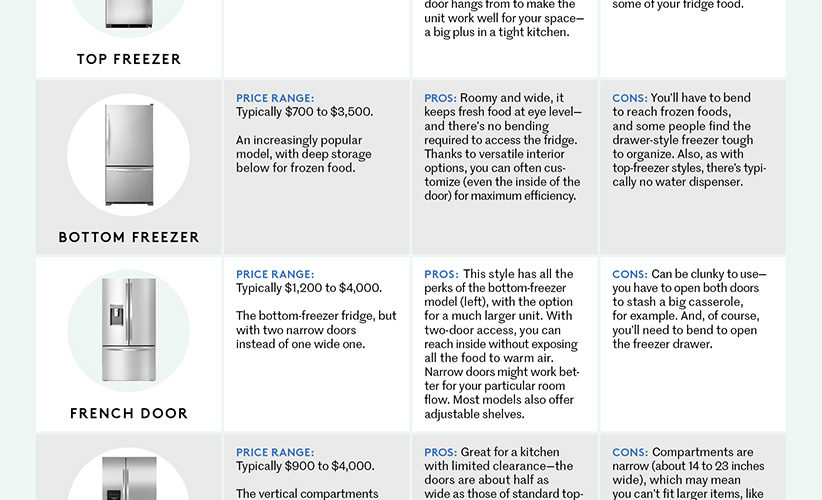If the refrigerator currently in your kitchen is no longer keeping foods as chilled or as frozen as it once did when it was new, or no longer offers you the storage space or features you need, it may be time to choose a refrigerator to replace your old, outdated and energy-inefficient model. But since a refrigerator represents a major expenditure and is one of the most often used appliances in your home, it’s important to follow a few key tips on how to choose the right refrigerator for your specific needs.
Be sure to take accurate measurements of the refrigerator you currently have or of the space where you plan on installing the new unit. Include height, width and depth, along with the space available to fully open both freezer and refrigerator doors. You don’t want to fall in love with a new refrigerator model that is too big or too small to fit into your designated kitchen space. Also look at your current unit to find out the cubic square feet of compartment space and decide if you need the same amount, or perhaps even more or less space in the new refrigerator. An empty refrigerator on the showroom floor might look pretty spacious, but unless it compares with the compartment space you now have, you might be sorely disappointed once the unit is in place and you find out you’ve mistakenly purchased less cubic square feet.
Decide what style of refrigerator you want. Do you want a freezer compartment located above or below the refrigerated compartment? Do you want a side by side unit, where one door opens the freezer and the other door opens the refrigerator? In which direction must the door swing in order to comfortably open both the freezer and refrigerator compartments? If you find a unit with a door that swings in the opposite direction, ask if the door can be mounted to open from the opposite direction instead as some models allow this alteration.
How important is it for you to have special features such as a built-in automatic ice maker or a unit that dispenses chilled water? Don’t forget that such features increase the cost of the refrigerator and sometimes require special maintenance or repairs.
Give consideration to the amount of shelves and their spacing, including if they can be rearranged to accommodate the height and width of a variety of food and beverage products such as soft drink bottles and milk cartons. Determine if it’s important to you to have specific compartments to hold butter, eggs and dairy or racks that cradle wine while it is chilling. Do you like to have separate compartments for storage meats or fresh produce?
If you need your new refrigerator to blend in with your current kitchen decor, take a digital photo of the color or finish of the unit to get an exact match. A refrigerator that looks like a close match under florescent lighting might look different once you get it into your kitchen.
Most refrigerators sold today list an estimate of what it will cost to operate the unit annually. If your utility budget is a concern, look for refrigerators with the Energy Star label and ask the sales person if you can quality for any energy rebates by purchasing an energy efficient model. Some municipalities offer rebates to homeowners who trade in an old energy guzzling refrigerator for a new energy efficient model. You just may luck out and receive $100 or more toward purchasing your new refrigerator!
Before you choose a refrigerator, find out the exact terms of the warranty and if an extended service contract comes with your purchase or must be purchased for an additional fee.



